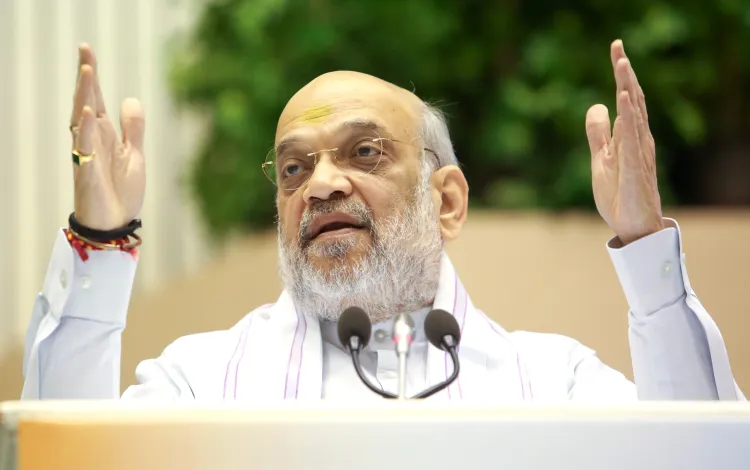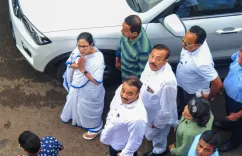Has India Really Achieved the 'Zero Casualty' Goal in Disaster Management?

Synopsis
Key Takeaways
- India has achieved 'Zero Casualty' in disaster management.
- Proactive strategies are now prioritized over reactive measures.
- Community engagement is integral to disaster response.
- Significant budget increases for disaster response forces.
- Climate change poses new challenges for disaster management.
New Delhi, June 16 (NationPress) Union Home Minister Amit Shah announced that under the leadership of Prime Minister Narendra Modi, the nation has successfully met the 'Zero Casualty' target during disasters over the last decade, positioning India as a potential global leader in crisis management.
Speaking at the annual conference of Relief Commissioners and Disaster Response Forces from various States and Union Territories, HM Shah noted, “In the past 10 years, we have made remarkable progress in capacity, speed, efficiency, and accuracy.”
“The essence of any disaster management operation is speed. Timely disaster responses and saving lives remain our top priority, which we have significantly improved through workforce training and the implementation of technology and advanced community warning systems,” he emphasized.
HM Shah expressed confidence in the National Disaster Response Force (NDRF), stating it has developed a solid reputation and gained respect nationwide, despite operating under his ministry.
The NDRF has diligently trained personnel from the State Disaster Relief Force (SDRF), he added.
He commended the National Disaster Management Authority (NDMA), NDRF, and the Coalition for Disaster Resilient Infrastructure (CDRI) for driving India closer to becoming a leading figure in global disaster management.
HM Shah remarked that disaster management a decade ago primarily focused on relief post-calamity, whereas now, India's approach emphasizes a 'Zero Casualty Approach', impressing the international community.
The Union Minister highlighted the necessity for research to enhance advanced warning systems for disaster response and mitigation.
“We have transitioned our disaster response from a reactive to a proactive model over the past decade,” he stated, adding that the concept of 'Bhagidhari' has been pivotal in refining the response system.
“A collaborative approach has been implemented, involving everyone from the Central government to local bodies. Under Prime Minister Modi, community engagement has been integrated into our disaster response efforts,” he explained.
HM Shah asserted that by the end of this decade, every young individual in the nation will possess the skills necessary to contribute to disaster response.
Highlighting the government's multi-faceted strategy, he noted that budget allocations for disaster response forces have tripled over the past ten years.
“For the NDRF, the budget was Rs 28,000 crore from 2004 to 2014, which increased to Rs 84,000 crore from 2014 to 2024,” he mentioned.
In the case of the SDRF, the allocation rose from Rs 38,000 crore between 2004 and 2014 to Rs 1.44 lakh crore from 2014 to 2024.
The Coalition for CDRI, initiated by PM Modi, is a global consortium of 49 members focused on climate and disaster-resilient infrastructure solutions.
This partnership includes national governments, UN agencies, multilateral development banks, the private sector, and academia, all working towards advancing climate and disaster-resilient infrastructure (DRI).
According to HM Shah, in the past two years, various relief and disaster management agencies have come together on a single platform, adopting a 'Whole of Government' approach to establish a think tank for unified operations.
This collaboration has helped address deficiencies and prepared the nation to tackle disasters more effectively. Additionally, a multi-stakeholder approach and inter-agency cooperation have been successfully implemented.
HM Shah pointed out that due to climate change and global warming, disasters are increasingly affecting the whole world.
He praised the NDMA for its significant contributions in policy frameworks, research, training material dissemination, app development, and overall coordination.
During the Modi administration, there has been a notable shift in disaster management strategies, he observed.
He underlined the importance of anticipating future disasters, conducting advanced research, gathering global insights, and customizing them to fit India's geographical context.
HM Shah stated, “India has made substantial progress in developing early warning systems. Preparedness has been synchronized with our calendar, a scientific approach for active prevention and mitigation has been established, and we have seen considerable success in reducing disaster risks.”
By striving for the goal of 'Minimum Casualty', the Modi government has astounded the world by achieving the 'Zero Casualty' target in a decade.
He highlighted that in 1999, a super cyclone devastated Odisha, resulting in 10,000 fatalities, while during Cyclone Fani in 2019, only one life was lost.
Most impressively, during Cyclone Biparjoy in Gujarat, there were zero casualties, illustrating that when local units, the public, state and central governments, all departments, scientists, and security forces collaborate, extraordinary outcomes are possible.






